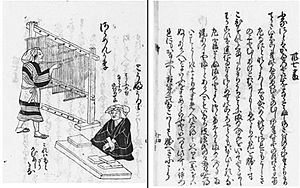Sōmen facts for kids
 |
|
| Alternative names |
|
|---|---|
| Type | Noodles |
| Place of origin | China |
| Region or state | East Asia |
| Main ingredients | Wheat flour |
| Regional names | |||||||||
|---|---|---|---|---|---|---|---|---|---|
| Historical name | |||||||||
| Chinese | 索麵 | ||||||||
| Literal meaning | rope noodle | ||||||||
|
|||||||||
| Chinese name | |||||||||
| Traditional Chinese | 素麵 | ||||||||
| Simplified Chinese | 素面 | ||||||||
| Literal meaning | white noodle | ||||||||
|
|||||||||
| Korean name | |||||||||
| Hangul | 소면 | ||||||||
| Hanja | 素麵 | ||||||||
|
|||||||||
| Japanese name | |||||||||
| Kanji | 素麺 | ||||||||
| Kana | そうめん | ||||||||
|
|||||||||
Sōmen (Japanese: 素麺), somyeon (Korean: 소면; 素麵), or sùmiàn (Chinese: 素麵) are super thin noodles. They are made from wheat flour. These noodles are less than 1.3 millimeters wide, which is very thin! They are used a lot in cooking across East Asia.
Japanese sōmen is made by stretching the dough with vegetable oil. This forms long, thin strands that are then air-dried. This way of making them is different from a similar thin noodle called hiyamugi, which is cut with a knife.
In Japan, sōmen is often served cold with a light dipping sauce called tsuyu. In South Korea, somyeon can be eaten in hot or cold noodle soups. Sōmen usually has a good amount of sodium (salt).
Other names for these noodles include nyūmen (煮麺) in Japanese. This is for a version served warm in soup. The Chinese name is guàmiàn (Chinese: 掛麵). This can be further divided into lóngxū (Chinese: 龍鬚; literally "Dragon Whiskers") for very long and thin noodles, and fèngwei (Chinese: 鳳尾; literally "Phoenix Tail") for flat and wide ones.
Contents
Sōmen Noodles in East Asia
Sōmen in Japan
In Japan, sōmen noodles are usually served cold. They come with a light dipping sauce called tsuyu. This sauce is often made from katsuobushi (dried bonito flakes). You can add flavors to the tsuyu like Japanese bunching onion, ginger, or myoga.
During the hot summer, sōmen chilled with ice is a very popular meal. It helps people stay cool. When sōmen is served in hot soup, it's usually called nyūmen. People eat nyūmen in the winter, just like they eat soba or udon noodles.
Flowing Noodles: Nagashi-sōmen
Some restaurants offer a fun experience called nagashi-sōmen (流しそうめん). This means "flowing noodles." In the summer, the noodles are placed in a long bamboo flume. This flume runs across the restaurant.
The flume carries clear, ice-cold water. As the sōmen noodles float by, diners use their chopsticks to catch them. Then, they dip the noodles in tsuyu sauce. Catching the noodles needs good hand-eye coordination! Noodles that aren't caught usually aren't eaten. This makes it a fun challenge to catch as many as you can.
Some fancy places even put their sōmen in real streams. This lets people enjoy their meal in a beautiful garden. You can also buy machines that let you have this "flowing noodle" experience at home.
Sōmen in South Korea
In Korean cuisine, somyeon noodles are used in both hot and cold noodle soups. Examples include janchi-guksu (which means "banquet noodles") and kong-guksu (noodles in cold soybean soup).
Somyeon is also used in noodle dishes that don't have soup. One example is bibim-guksu (mixed noodles). These noodles are often served with spicy anju. Anju is food that people eat with alcoholic drinks. An example is golbaengi-muchim (moon snail salad).
-
Golbaengi-muchim served with boiled somyeon.
Images for kids
See also
 In Spanish: Sōmen para niños
In Spanish: Sōmen para niños










